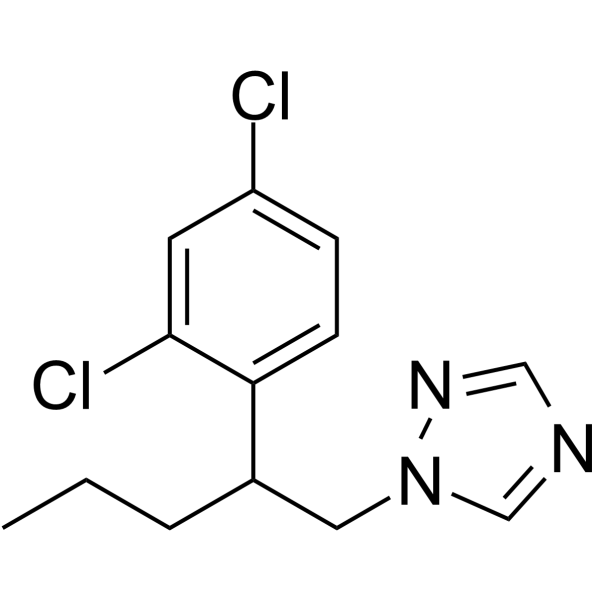Physicochemical Properties
| Molecular Formula | C13H15CL2N3 |
| Molecular Weight | 284.18 |
| Exact Mass | 283.064 |
| CAS # | 66246-88-6 |
| Related CAS # | Penconazole-d7;1628110-84-8 |
| PubChem CID | 91693 |
| Appearance | Off-white to light yellow solid powder |
| Density | 1.3±0.1 g/cm3 |
| Boiling Point | 415.3±55.0 °C at 760 mmHg |
| Melting Point | 57.6-60.3ºC |
| Flash Point | 204.9±31.5 °C |
| Vapour Pressure | 0.0±1.0 mmHg at 25°C |
| Index of Refraction | 1.602 |
| LogP | 3.66 |
| Hydrogen Bond Donor Count | 0 |
| Hydrogen Bond Acceptor Count | 2 |
| Rotatable Bond Count | 5 |
| Heavy Atom Count | 18 |
| Complexity | 252 |
| Defined Atom Stereocenter Count | 0 |
| InChi Key | WKBPZYKAUNRMKP-UHFFFAOYSA-N |
| InChi Code | InChI=1S/C13H15Cl2N3/c1-2-3-10(7-18-9-16-8-17-18)12-5-4-11(14)6-13(12)15/h4-6,8-10H,2-3,7H2,1H3 |
| Chemical Name | 1-[2-(2,4-dichlorophenyl)pentyl]-1,2,4-triazole |
| HS Tariff Code | 2934.99.9001 |
| Storage |
Powder-20°C 3 years 4°C 2 years In solvent -80°C 6 months -20°C 1 month |
| Shipping Condition | Room temperature (This product is stable at ambient temperature for a few days during ordinary shipping and time spent in Customs) |
Biological Activity
| ln Vivo | In rat cerebrum and cerebellum tissues, penconazole (67 mg/kg; ip; every 2 days for 9 days) causes oxidative stress[2]. Penconazole has been shown to cause oxidative damage in the adult rat brain through changes in the enzymatic and nonenzymatic antioxidant status, as well as an increase in lipid peroxidation and protein oxidation. Penconazole also has an impact on brain histoarchitecture, membrane-bound ATPase activity, and the cholinergic system. Penconazole is a pesticide with the potential to be neurotoxic; it works by causing oxidative stress. In adult rats, penconazole significantly reduces AChE activity in the cerebellum (25%) and brain (11%), respectively[2]. |
| Animal Protocol |
Animal/Disease Models: Twelve male Wistar rats[2] Doses: 67 mg/kg Route of Administration: Ip; every 2 days during 9 days Experimental Results: A significant increase was obtained in the absolute and relative weights of the cerebrum and cerebellum, respectively. |
| References |
[1]. Acute exposure to the penconazole-containing fungicide Topas partially augments antioxidant potential in goldfish tissues. Comp Biochem Physiol C Toxicol Pharmacol. 2017;193:1-8. [2]. Penconazole alters redox status, cholinergic function, and membrane-bound ATPases in the cerebrum and cerebellum of adult rats. Hum Exp Toxicol. 2017;36(8):854-866. |
| Additional Infomation |
1-[2-(2,4-dichlorophenyl)pentyl]1,2,4-triazole is a member of the classof triazoles that is 1,2,4-triazole substituted at position 1 by a 2-(2,4-dichlorophenyl)pentyl group. It is a dichlorobenzene and a member of triazoles. Topaz is a mineral with formula of Al2SiO4F2. The IMA symbol is Tpz. |
Solubility Data
| Solubility (In Vitro) | DMSO : 100 mg/mL (351.89 mM) |
| Solubility (In Vivo) |
Solubility in Formulation 1: ≥ 2.5 mg/mL (8.80 mM) (saturation unknown) in 10% DMSO + 40% PEG300 + 5% Tween80 + 45% Saline (add these co-solvents sequentially from left to right, and one by one), clear solution. For example, if 1 mL of working solution is to be prepared, you can add 100 μL of 25.0 mg/mL clear DMSO stock solution to 400 μL PEG300 and mix evenly; then add 50 μL Tween-80 to the above solution and mix evenly; then add 450 μL normal saline to adjust the volume to 1 mL. Preparation of saline: Dissolve 0.9 g of sodium chloride in 100 mL ddH₂ O to obtain a clear solution. Solubility in Formulation 2: 2.5 mg/mL (8.80 mM) in 10% DMSO + 90% (20% SBE-β-CD in Saline) (add these co-solvents sequentially from left to right, and one by one), suspension solution; with ultrasonication. For example, if 1 mL of working solution is to be prepared, you can add 100 μL of 25.0 mg/mL clear DMSO stock solution to 900 μL of 20% SBE-β-CD physiological saline solution and mix evenly. Preparation of 20% SBE-β-CD in Saline (4°C,1 week): Dissolve 2 g SBE-β-CD in 10 mL saline to obtain a clear solution. Solubility in Formulation 3: ≥ 2.5 mg/mL (8.80 mM) (saturation unknown) in 10% DMSO + 90% Corn Oil (add these co-solvents sequentially from left to right, and one by one), clear solution. For example, if 1 mL of working solution is to be prepared, you can add 100 μL of 25.0 mg/mL clear DMSO stock solution to 900 μL of corn oil and mix evenly. (Please use freshly prepared in vivo formulations for optimal results.) |
| Preparing Stock Solutions | 1 mg | 5 mg | 10 mg | |
| 1 mM | 3.5189 mL | 17.5945 mL | 35.1890 mL | |
| 5 mM | 0.7038 mL | 3.5189 mL | 7.0378 mL | |
| 10 mM | 0.3519 mL | 1.7594 mL | 3.5189 mL |
